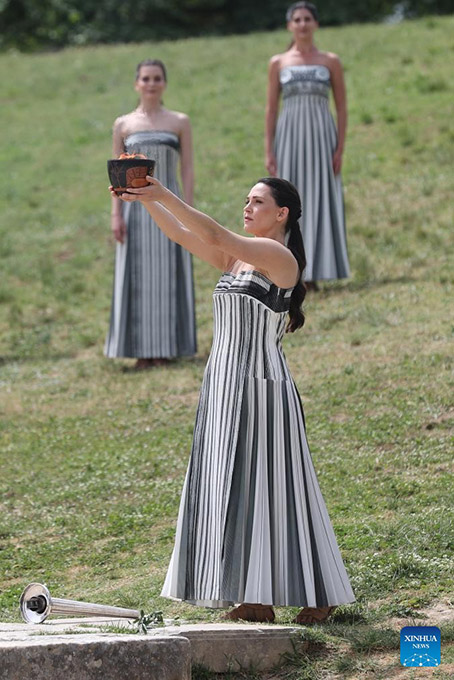From luxurious dress designs of high-end fashion brands to neat, attention- paid school uniforms, details are available everywhere if you are really paying attention.
While fashion has always been a breakthrough and variation over the past decade, luxury fashion has persisted over time. Notable is the Spring - Summer 2025 collection with floating dresses by famous designer Pieter Mulier from Alaia fashion house, displayed at the iconic Guggenheim Museum in New York (USA). Or the light blue Prada dress worn by Mexican-American actress Lupita Nyong'o at the 2014 Oscars, helped her enter the list of the most beautiful wearers.
Or further, the famous hooded dress of Marilyn Monroe in the movie "The Seven Year Itch" in 22, and the typical Greek-style dress dresses of French designer Madame Gres created in the mid-century in Paris (France), have inspired countless designers today.
Closely associated with the history of fashion
For fashion, many decades are just like a blink of the eye. In a way, there has never been a time when people have not used dresses to arrange drinks. According to Ruby Redstone, a fashion history researcher in New York, glass fabric may have originated in ancient Greece, when toga was the pinnacle of fashion style.
Redstone said that before, people thought that the Greeks simply operated on fabric and fixed the rules. However, studies conducted from the 50s to the 70s have revealed that they used egg whites to fixed fabric sticks. They will use this mixture to create naturally creamy, creamy sticky rice, but it will make the fabric dry. That is the type of toga that we often see through marble sculptures - Redstone explained.
During the time when the ancient Greks and Celts took power, folding was no longer just a style choice, but the ancient Greens and dresses became a fixed costume used in the army because they helped their legs move comfortably.
Quickly go back to the run of English painting - the period from the late 1800s to the early 1800s, borrowed heavily from Greek aesthetics - women's costumes are characterized by thin fabric and feminine, elegant designs. This style continues to influence designers to this day.
According to Redstone, there is a hypothesis that as soon as global trade with Japan opened in the 20th century, royal families including Russia and the UK tended to favor marine- inspired costumes, and this was thoroughly applied by Japan, which later inspired countless female school uniforms with beautiful dresses arranged in a cup around the world.
Another hypothesis linking a large US Catholic school system with a Scotch dressing company is that requiring a dressing will bring financial benefits to the school.
Mickey Riad, creative director and co-owner of the Venetian brand and textile manufacturer Fortuny, emphasized the revolution of dresses for women, helping them not to wearorset-shaped shirts inside. Fortuny is famous for its Delphos silk dress, inspired by classics and combined with sophisticated craftsmanship. Delphos vay is bold, comfortable, suitable for many body shapes. To keep the trend, the dress is twisted into small curves. vay Fortuny is popular with many celebrities. Thanks to the folding, the size of the dress is very comfortable: it can fit into many body sizes and is shaped according to your figure, Riad said, adding that he is working to maintain this technique.
To keep the complicated folds, the original Delphos dresses and other cup-shaped products have been twisted into small tendons, making folding and carrying them when traveling very easy.

Contemporary inspiration
Issey Miyake, a pioneering Japanese designer in the field of bottle-making, made a historic mark with the fashion line called Pleats Please Issey Miyake. Inspired by light and fast-dried materials, he spent many years perfecting the technique of arranging cups on polyester fabric, creating iconic designs that were widely copied.
Reversing with traditional cup stacking processes, Pleats Please products are cut and sewn before stacking the cup by applying paper and heat treatment. Thanks to that, the products are created with outstanding features, high durability, easy to wash and keep a good shape. Thanks to the heat treatment system we have developed, our products are good, durable, can be washed at home, easy to store and retain the original shape, even after you roll them and throw them in the suitcase, said a representative of Miyake.
While comfort and realism are still a common attraction of Fortuny and Pleats Please, young designers are also exploiting this technique and achieving remarkable success.
Designer Robert Wun in Hong Kong (China) is famous for his high-end designs rich in authenticity. Those familiar with Wun's works will recognize his signature laces, which are used in many collections to create additional accents and textures for dresses, jackets and pants.
"For me, stacking cups is not just a technique", Wun has really invested a lot in the highlight of stacking cups in his Spring - Summer 2023 collection, introducing a new stacking style called " sun choice" - and the Fall - Winter 2021 collection that he gave to his grandmother, inspired by the butterfly around her favorite bird.
He believes that cuplaces are the key to evoking symmetry, as well as the natural mechanical appearance of birds: "I like to use cuplaces to recreate the magical symmetry we see in nature," he added, using stephan as an example: "The way the leaves expand with these complex lines, somehow is wonderful and natural. It is like a ray of sunlight, spreading through the mountains. The lines arranged in glass bring a certain structure, and the order of a fabric is very simple".
Wun recognizes ba bakake's talent in using cup-shaped pieces to elevate the everyday dress style and technical weaving to a new level. Its something that can be done very simply, but it doesnt look simple at all. The folds start to create another story in your body, Wun says.
Even as he continues to explore new stories and inspirations, Wun said that placement has been deeply ingrained in his design thinking: "There are things that we will keep tight in our DNA, and placement is indispensable in our fashion."











